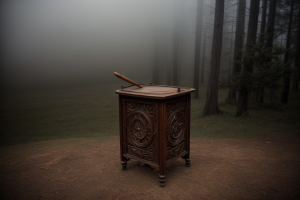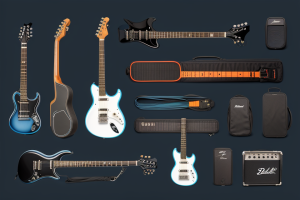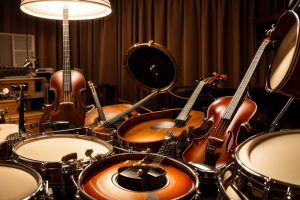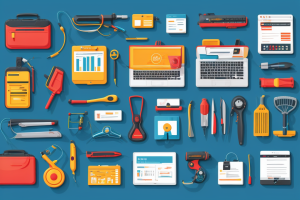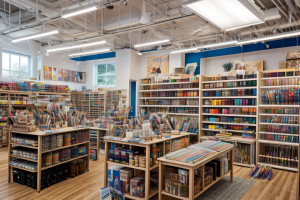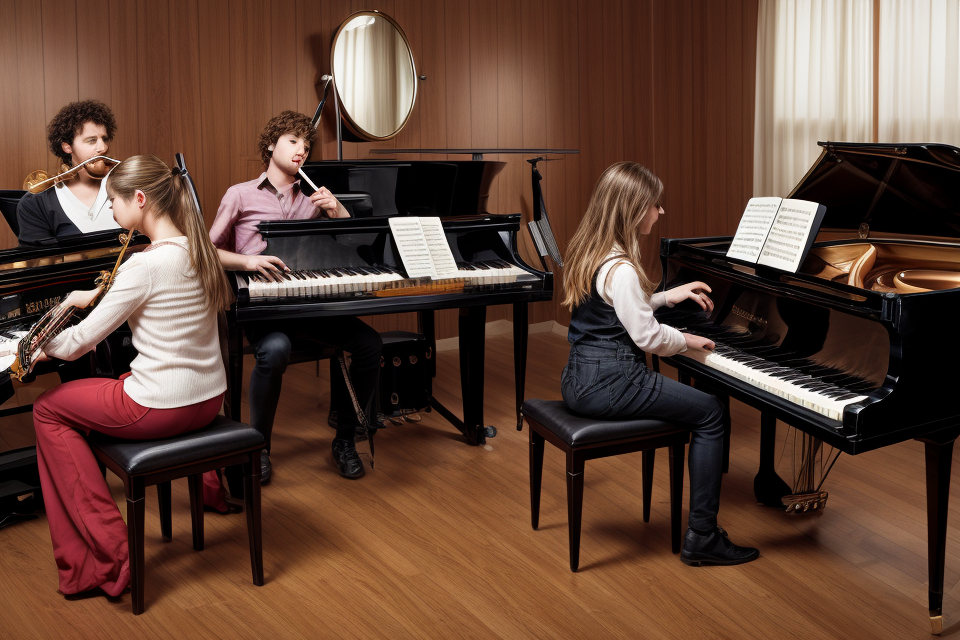
As a musician, it’s important to take good care of your instrument to ensure that it lasts for many years to come. However, there are some common mistakes that you should avoid when using your instrument. These mistakes can not only damage your instrument but can also affect the sound quality of your music. In this article, we will discuss the top 5 common mistakes that you should avoid when using your instrument. From neglecting maintenance to using the wrong accessories, these mistakes can have a significant impact on the performance of your instrument. So, read on to find out what you should avoid doing to keep your instrument in top condition.
Proper Maintenance of Your Instrument
Cleaning Your Instrument Regularly
- Cleaning your instrument regularly is essential to ensure its longevity and to maintain its optimal performance.
- A soft, dry cloth should be used to wipe down the instrument after each use. This will remove any dust, dirt, or debris that may have accumulated on the surface of the instrument.
- Avoid using harsh chemicals or cleaners, as they can damage the finish or the wood. Harsh chemicals can cause discoloration, damage the wood, or even cause cracks in the finish.
- Clean the instrument before storing it, to prevent dust buildup. Dust can accumulate in the crevices of the instrument and cause damage over time. Therefore, it is important to clean the instrument thoroughly before storing it, especially if it will be stored for an extended period of time.
Additionally, it is important to keep the instrument in a case when not in use. This will protect it from accidental damage and will also help to maintain its shape and integrity. The case should be big enough to accommodate the instrument and any accessories that may be included, such as a bow or a music stand.
Adjusting the Instrument to Your Body
One of the most important aspects of playing a musical instrument is ensuring that it is properly adjusted to fit your body. This is particularly true for string instruments such as the violin, viola, and cello, which require a certain level of physical contact between the player and the instrument. Failing to adjust the instrument to your body can lead to discomfort, poor posture, and even injury. Here are some tips for adjusting your instrument to your body:
- Use a shoulder rest to prevent the instrument from slipping or becoming unbalanced. A shoulder rest should be firmly attached to the instrument and should fit snugly against your shoulder. It should not be so high that it interferes with your ability to hold the instrument, but it should provide enough support to keep the instrument in place.
- Adjust the height of the seat and the angle of the chinrest to fit your body. The height of the seat should be adjusted so that your feet are flat on the floor and your knees are at a 90-degree angle. The angle of the chinrest should be adjusted so that your chin is firmly against the rest and your jaw is relaxed.
- Make sure the instrument is the right size for you, and that the strings are not too high or too low. The size of the instrument should be appropriate for your body size and playing ability. If the strings are too high, it can be difficult to press them down with the bow, and it can cause discomfort in your hand and arm. If the strings are too low, it can be difficult to hold the instrument and maintain good posture.
Overall, adjusting your instrument to your body is essential for comfortable and effective playing. By following these tips, you can help prevent discomfort and injury and ensure that you get the most out of your instrument.
Storing the Instrument Properly
Proper storage of your instrument is crucial to ensure its longevity and maintain its optimal condition. Here are some tips to follow when storing your instrument:
- Store the instrument in a case or a stand when not in use
It is essential to keep your instrument in a protective case or stand when not in use. This helps to prevent any damage to the instrument and keeps it in good condition. A hard case is recommended for most instruments, as it provides better protection against impacts and bumps.
- Avoid exposing the instrument to extreme temperatures or humidity
Extreme temperatures and humidity can cause damage to your instrument. Avoid storing your instrument in areas with extreme temperatures, such as near heating or air conditioning vents. Also, avoid exposing your instrument to direct sunlight or bright lights, as this can cause damage to the finish or the wood.
- Keep the instrument away from direct sunlight or bright lights
Direct sunlight and bright lights can cause damage to your instrument’s finish and wood. This damage can result in discoloration, cracks, or warping of the wood. To prevent this, store your instrument in a cool, dry place, away from direct sunlight or bright lights.
Protecting Your Instrument
Using the Right Accessories
- Choosing the right bow is crucial for both sound production and instrument protection. The bow should be the appropriate size and weight for your instrument to produce a clear and consistent tone. It is also important to ensure that the bow is made of high-quality materials to prevent cracking or breaking.
- Using a case that is designed specifically for your instrument is essential for protecting it from damage. The case should provide adequate padding and support to prevent scratches, dents, and other types of damage. Additionally, the case should be able to fit your instrument comfortably and securely to prevent it from moving around during transportation.
- Investing in additional accessories, such as rosin or a music stand, can greatly enhance your playing experience. Rosin is necessary for producing a good bowing sound, and a high-quality music stand can help you keep your music organized and within easy reach. These accessories may seem minor, but they can make a significant difference in your overall playing experience.
Avoiding Damaging the Instrument
When using your instrument, it’s important to take proper care of it to prevent any damage. Here are some common mistakes to avoid:
- Avoid exposing the instrument to extreme temperatures or humidity: This can cause the wood to crack or warp, affecting the sound quality and overall condition of the instrument. Be sure to keep your instrument in a stable environment, away from direct sunlight and sources of heat or cold.
- Avoid touching the strings or the fingerboard with your fingers: Oils from your skin can damage the strings and fingerboard, causing them to tarnish or corrode. Use a soft cloth or cleaning solution to wipe down the instrument after each use.
- Avoid using excessive force when playing or adjusting the instrument: This can cause the tuning to go out of whack or even cause permanent damage to the instrument. Always use a gentle touch when playing or adjusting the instrument, and be sure to use the proper tools and techniques when making any adjustments.
Playing the Instrument Properly
Developing Proper Technique
Practice Regularly and Consistently
Regular and consistent practice is crucial to developing proper technique on your instrument. This means setting aside a specific time each day to practice and making it a priority. It is important to have a structured practice routine that includes warm-up exercises, scales, and pieces you are working on. Consistency is key to making progress and improving your skills.
Learn Proper Bowing and Fingering Techniques
Proper bowing and fingering techniques are essential to playing your instrument correctly. These techniques can vary depending on the instrument you play, but it is important to learn the correct way to hold the bow and use it to produce a good sound. Additionally, proper fingering techniques can help you play with accuracy and avoid common mistakes such as squeezing notes or playing out of tune.
Work on Building Strength and Endurance in Your Fingers and Arms
Playing an instrument requires strength and endurance in your fingers and arms. This is especially true for instruments that require a lot of finger movement, such as the piano or violin. It is important to incorporate exercises into your practice routine that help build strength and endurance in your fingers and arms. This can include finger exercises, scales, and exercises that require you to use your fingers and arms in different ways. Building this strength and endurance will help you play with more precision and avoid fatigue.
Practicing Effectively
When it comes to mastering an instrument, practice is key. However, not all practice is created equal. To make the most of your time and efforts, it’s important to practice effectively. Here are some tips to help you do just that:
- Set clear goals for each practice session: Before you begin practicing, take a few minutes to set clear goals for your session. What do you want to accomplish? Do you want to work on a specific piece or technique? Having clear goals will help you stay focused and motivated during your practice sessions.
- Warm up before playing and cool down afterwards: Just like you would stretch before a workout, it’s important to warm up before playing your instrument. This can be as simple as playing a few scales or arpeggios to get your fingers and hands limbered up. After you finish practicing, take a few minutes to cool down by playing some slow, relaxing pieces. This will help your hands and fingers return to their normal state.
- Practice slowly and deliberately, focusing on specific sections or passages: It’s easy to get caught up in the excitement of playing your instrument and want to rush through pieces. However, taking the time to practice slowly and deliberately can help you make significant improvements. Focus on specific sections or passages that you’re struggling with and work on them slowly and deliberately. This will help you build muscle memory and make the piece feel more natural to play.
By following these tips, you can ensure that you’re practicing effectively and making the most of your time and efforts.
Enjoying Your Instrument
Finding Inspiration
When it comes to playing your instrument, finding inspiration is key to enjoying your practice sessions and performances. Here are some tips to help you find inspiration for your instrument:
- Listen to recordings of other musicians playing the same instrument: By listening to other musicians who play your instrument, you can gain new ideas and inspiration for your own playing. This can be especially helpful if you’re struggling to find motivation or creativity in your own playing. Try listening to a variety of different styles and genres of music to broaden your horizons and find new inspiration.
- Attend concerts or recitals featuring the instrument: Another great way to find inspiration is to attend concerts or recitals featuring your instrument. This can give you a chance to hear live performances and see how other musicians approach their playing. It can also be inspiring to see the range of emotions and styles that can be expressed through your instrument.
- Experiment with different styles of music and find what you enjoy playing the most: It’s important to find music that resonates with you and inspires you to play. Experiment with different styles of music and find what you enjoy playing the most. Whether it’s classical, jazz, rock, or pop, there’s sure to be a style that speaks to you and helps you find inspiration in your playing.
Overall, finding inspiration is a crucial part of enjoying your instrument. By seeking out new experiences and exposing yourself to different styles of music, you can broaden your horizons and find new ideas for your own playing. So don’t be afraid to explore and experiment – you never know what you might discover!
Sharing Your Talent
Sharing your talent is an excellent way to enhance your musical journey and connect with others who share your passion for music. Here are some ways to share your talent:
- Play for friends and family: One of the best ways to share your talent is to play for friends and family. This is an excellent opportunity to showcase your skills and receive feedback from people who know you well. You can organize a small concert or gathering where you can play your instrument and invite your loved ones to enjoy your music.
- Consider joining a community orchestra or ensemble: Joining a community orchestra or ensemble is an excellent way to share your talent and meet other musicians. These groups are often open to musicians of all skill levels, and they provide an opportunity to play with other musicians and perform in front of an audience. This is an excellent way to improve your skills and meet new people who share your passion for music.
- Share your music on social media or through online platforms: Social media and online platforms provide an excellent opportunity to share your music with a wider audience. You can record your performances and share them on platforms like YouTube, Instagram, or Facebook. This is an excellent way to connect with other musicians and receive feedback from people who enjoy your music. You can also collaborate with other musicians and share your music with a larger audience.
FAQs
1. What are some common mistakes to avoid when using my instrument?
Answer:
When using your instrument, there are several common mistakes that you should avoid to ensure that you get the best possible sound and maintain the health of your instrument. Here are some of the most important things to keep in mind:
* Don’t use excessive force when playing. This can cause damage to the instrument and make it harder to play over time.
* Avoid exposing your instrument to extreme temperatures or humidity. This can cause damage to the wood and other materials used in the instrument, leading to cracks and other problems.
* Don’t allow your instrument to sit in its case for long periods of time without being played. This can cause the wood to dry out and become brittle, leading to cracks and other damage.
* Avoid using the wrong kind of accessories or cleaning materials on your instrument. Some products can damage the finish or other parts of the instrument, so it’s important to use only high-quality accessories that are specifically designed for your instrument.
* Don’t ignore any problems with your instrument. If you notice any issues, such as a loose string or a crack in the wood, it’s important to address them as soon as possible to prevent them from getting worse.
2. What are some tips for maintaining my instrument?
Maintaining your instrument is essential for ensuring that it stays in good condition and sounds its best. Here are some tips for keeping your instrument in top shape:
* Keep your instrument clean and free of dust and debris. Use a soft, dry cloth to wipe down the instrument after each use.
* Lubricate moving parts as needed. This can help to prevent sticking and other problems.
* Adjust the instrument as needed. For example, if the strings are too loose or too tight, it can affect the sound and playability of the instrument.
* Have your instrument checked by a professional on a regular basis. This can help to identify any problems early on and prevent them from becoming more serious.
* Consider investing in a humidifier to help maintain the proper humidity level in the instrument’s case. This can help to prevent the wood from drying out and becoming brittle.
3. What should I do if I notice a problem with my instrument?
If you notice a problem with your instrument, it’s important to address it as soon as possible to prevent it from getting worse. Here are some steps you can take:
* Identify the problem. Is it a loose string, a crack in the wood, or something else?
* Don’t try to fix the problem yourself if you’re not sure what you’re doing. This can cause further damage to the instrument.
* Take the instrument to a professional for repair. A qualified technician will be able to diagnose the problem and fix it properly.
* In the meantime, avoid playing the instrument until the problem is fixed. This can help to prevent further damage and ensure that the instrument stays in good condition.
4. Can I transport my instrument in its case?
It’s generally safe to transport your instrument in its case, but there are a few things you should keep in mind to ensure that the instrument stays in good condition. Here are some tips for transporting your instrument:
* Make sure the case is properly padded and sturdy. A good case will help to protect the instrument from bumps and bruises during transport.
* Don’t overfill the case with accessories or other items. This can put extra pressure on the instrument and cause damage.
* Secure the instrument in the case to prevent it from moving around during transport. Use the straps or other fasteners provided with the case to keep the instrument snug and secure.
* Avoid exposing the instrument to extreme temperatures or humidity while it’s in the case. This can cause damage to the wood and other materials used in the instrument.
